Our off-grid Power Upgrades
When we bought our first van, I upgraded the batteries from the stock 105AH AGM to twin 140AH AGM. Unfortunately that van was written off after 6 months (money refunded – floor was rotting due to water leaks, that’s a whole other story!). Fortunately I was able to salvage the batteries from the old van and transferred them to the new one.
I had a second battery box fitted to the chassis of our new-to-us Essential Exceed II (ours battery was chassis mounted to start with) by the wonderful team at Lawrence RV in Brendale (great bunch of guys there too) so I could swap the batteries in. All worked great, had a couple of sections of our trip free camping and everything worked perfectly. Until about a year into our trip…
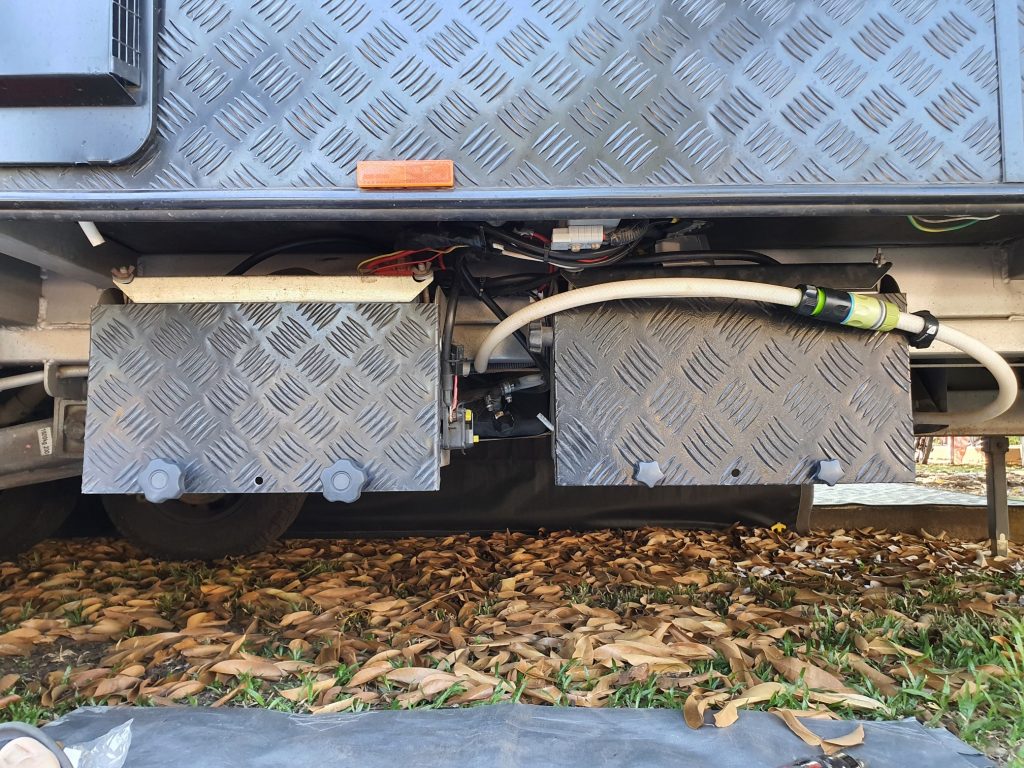
NOTE: Before we dive in too deeply, if you have not read my bio on the Who Are We page, my background is electronic engineering. So none of this was a gamble, confusing or difficult – for me. Before attacking something like this on your own, especially if you do not have much experience in working with power, please consult an expert. It may only be 12v, but 280AH batteries can cause electrical fires when short circuits occur.
Second Note: I am not saying this is the ideal solution, I am not saying these are the world’s best products, I am saying this is the best I could put together to suit my budget, my requirements, the timing needed, the situation I was in and research I had done. If I had to do over in the same circumstances would I change anything, probably not. If I had a do over from the beginning before we left for full time on the road would I do it differently, probably not as I didn’t have the funds to go Lithium then. If I had unlimited funds would I do it differently – hell yeah. I would be flying a light aircraft to each location, hiring a 4wd and hotel room!
OK, rant over, let’s get into it!
On a particularly cold night, we had the portable fridge running as usual (about 1.7amps) and the diesel heater running (about 1.5 amps) and all was great until about 3am when someone flushed the toilet and BEEP-BEEP-BEEP… I thought the fridge had been left open in my slumber induced haze. Nope, was the Victron Battery monitor beeping low battery. Both batteries had taken a turn for the worse and on testing a few weeks later one was at 19AH max capacity and the other 30AH max capacity. In hindsight, that was about the 4th night of -4° over a 2 week period of sub zero temps and may have (but should not have) had a negative effect. The test was done once we arrived at Katherine with low 30 degree days. With the batteries mounted externally they may not like those temps.. hmm. Lucky for us our plans now ‘should’ keep us away from winters, forever..
The supplier offers an 80% refund from 12 to 24 months old and these were close to 2 years, so I decided I should put that towards new Lithium Batteries. One thing I did have to be careful with was the depth of the batteries. The boxes are only 180mm deep and many newer batteries are 190mm deep. So this limited me to brand and size.
So I bought 2 Giant Power 140AH Lithium Iron Phosphate (LiFePo4) batteries, with a 100amp internal BMS (100amp continuous, 200amp for 5 seconds). Since I was getting an 80% refund on 2 year old batteries, the changeover was just over $1000 for both.
So why did I change over to Lithium? Much lighter (just saved over 40kg), better at handling high current loads, much better at handling low discharge state (these batteries are rated at 5000 cycles of 100% DOD (Depth of Discharge), so in other words can be run flat and recharged 5,000 times and still retain over 80% original capacity), safe (discussed below), and accept a charge faster than lead based – ideal for running free camp with solar.
Now lets jump sideways a little here and discuss safety – there is a lot of discussion on Social Media around Lithium based batteries being dangerous, that is they can explode, burst into flame etc. Yes, this is totally true for Lithium Polymer (and I have seen it and teach it in the Remote Aviation classes), and to a small extent Lithium Ion (regularly used in power tools), but LiFePo4 batteries do not burn, do not melt down, do not overheat, do not burst into flame even if punctured and to top it off contain no environmentally hazardous materials. They are in fact actually safer than a lead acid as there is no acid to spill and corrode.
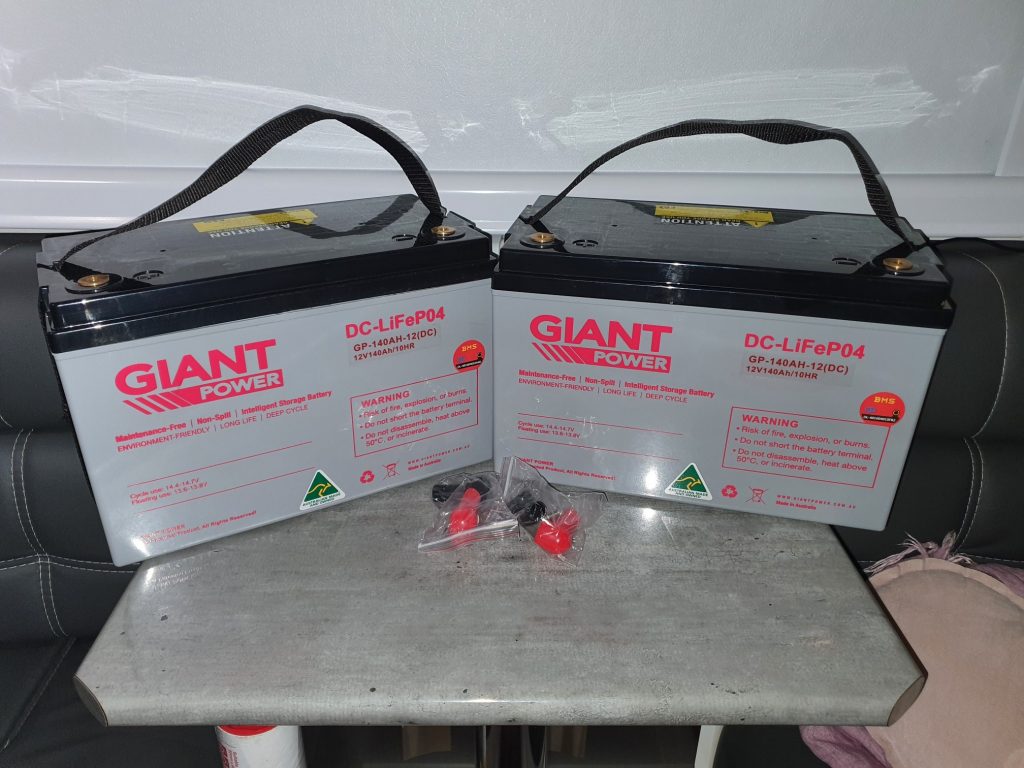
I removed the old 33kg each batteries and refitted with the new 12.5kg each batteries, so a net saving straight up of over 40kg!! That’s a huge bonus. Anyway, whilst i had them out I decided to see how long the cabling was and if it was possible to swap around the cabling. My original single battery of course had the positive and negative wiring connected directly to it, then the second battery was simply paralleled using 2B&S cables. This is fine for low to medium current applications as there is minimal voltage drop across the cables and both batteries will be always at the same voltage. However with large current draws there will be a small voltage drop across these cables so the primary battery will be loaded more than the secondary battery. How much this will affect the longevity of the batteries is honestly close to bugger all, despite the dire warnings you will se on the net (assuming adequate size link cabling is used). However, since I have a 3KW inverter drawing up to 200amps depending on load (that’s 200amps for a 2400w load) I wanted to try and balance the batteries properly (that install is covered on the Inverter blog post). To do this, you simply connect positive to one battery and negative to the other, still using the 2B&S cables to join them together in parallel. The 2B&S cables are rated at 188amps per metre, I am using 700mm cables so well capable of the maximum the battery’s BMS can provide.
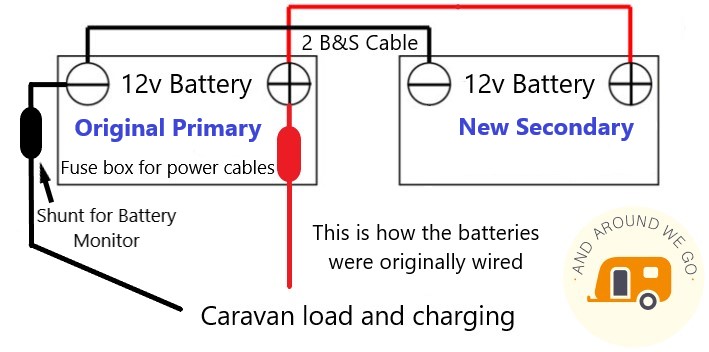
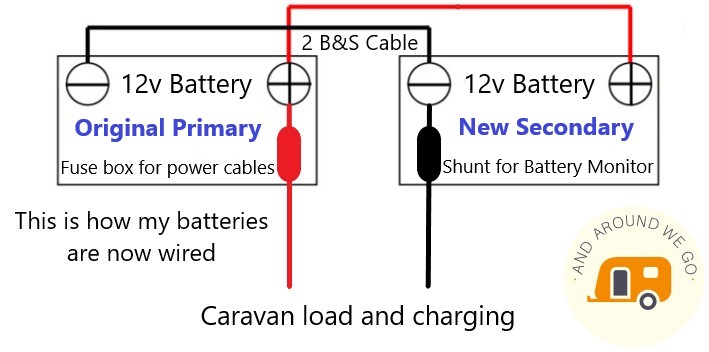
To my delight, the negative cabling was more than ample to swing across from the original primary battery position to the new secondary battery position. This gave me the perfect balance solution. It did mean cutting all the cable ties off and relocating to make it neat again. In addition, the original Solar Controller and BMPro Battery charger both had 6B&S cable from the cabinet to the battery. At around 2.5m of cable this is more than adequate for over 60 amps. So.. I disconnected the battery cables from the Solar Controller to the battery at both ends, connected the Battery end to the Anderson Connector (that was originally connected to the battery directly), then at the controller end I relocated the cables to join in with the input wiring from the roof solar panels. So now I have the roof solar and the external solar both running through the same MPPT controller. I then ran the output from the Solar Controller directly to the Battery terminals on the BMPro Battery Management system. Now both the AC and Solar will charge through the same cables. It can never never see more than 60 amps and will most likely never as the AC charger is max 30amps and the solar max 30 amps (and I currently only have 300W of Solar for a max 12amps or thereabouts).
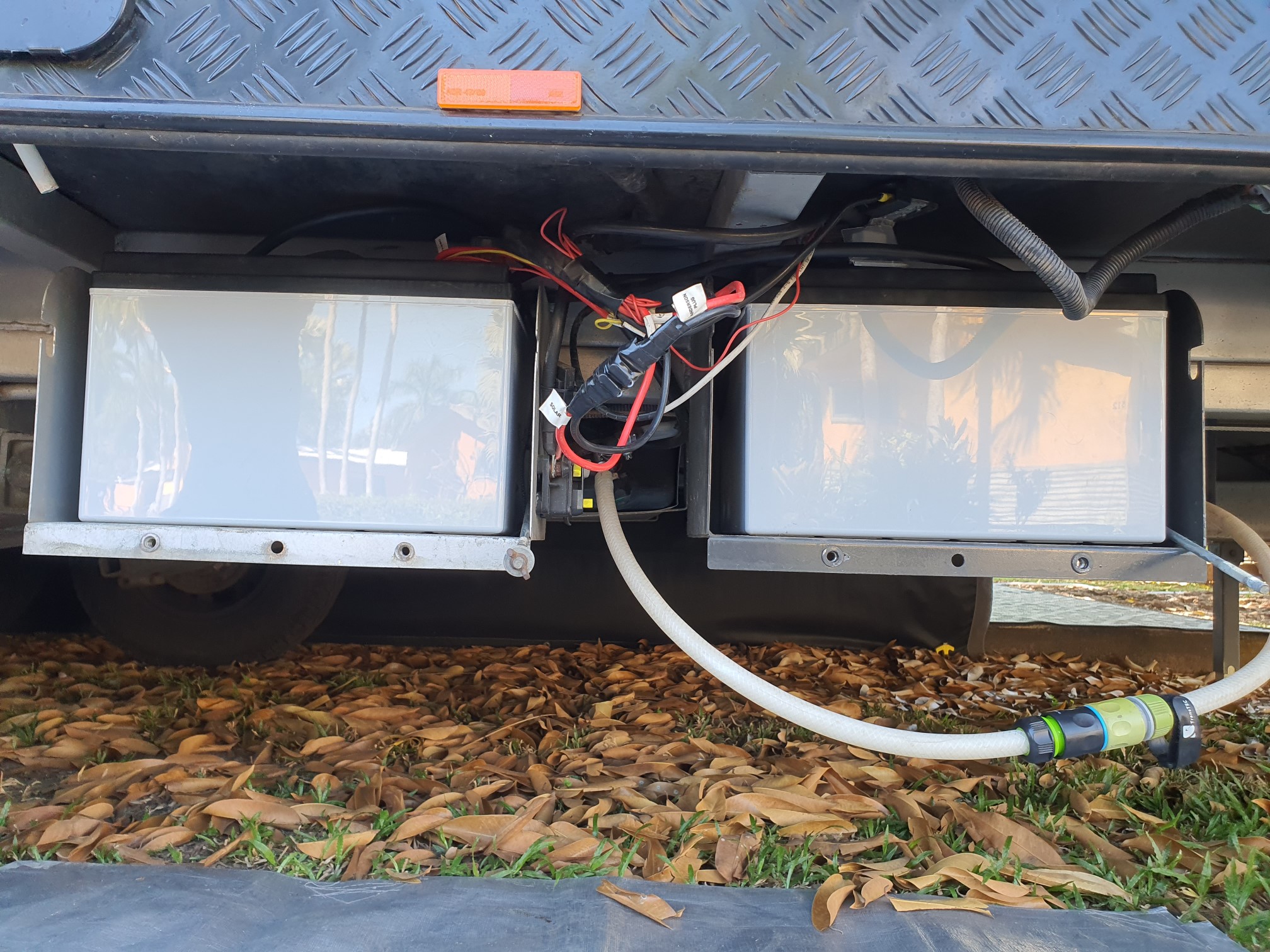
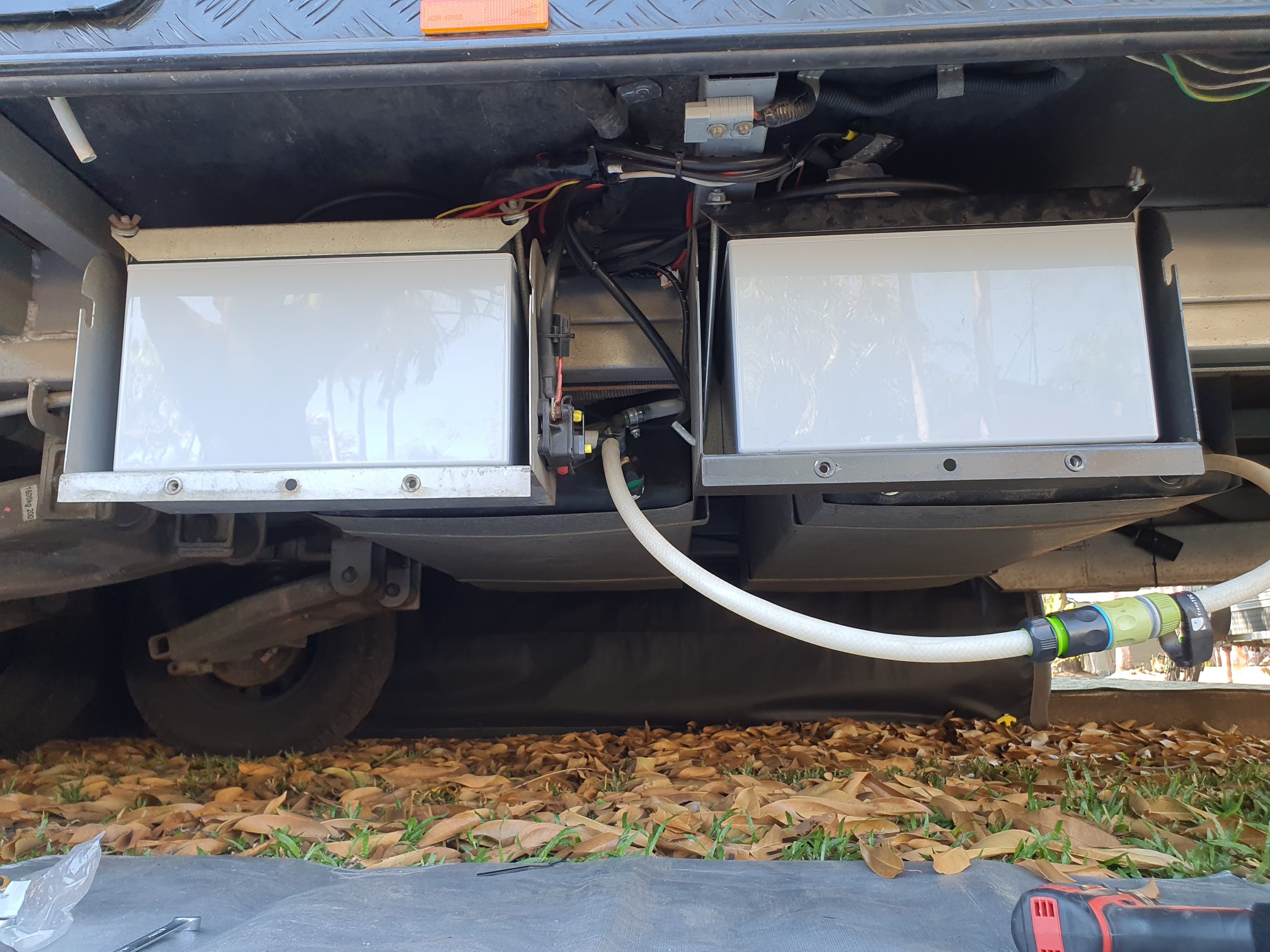
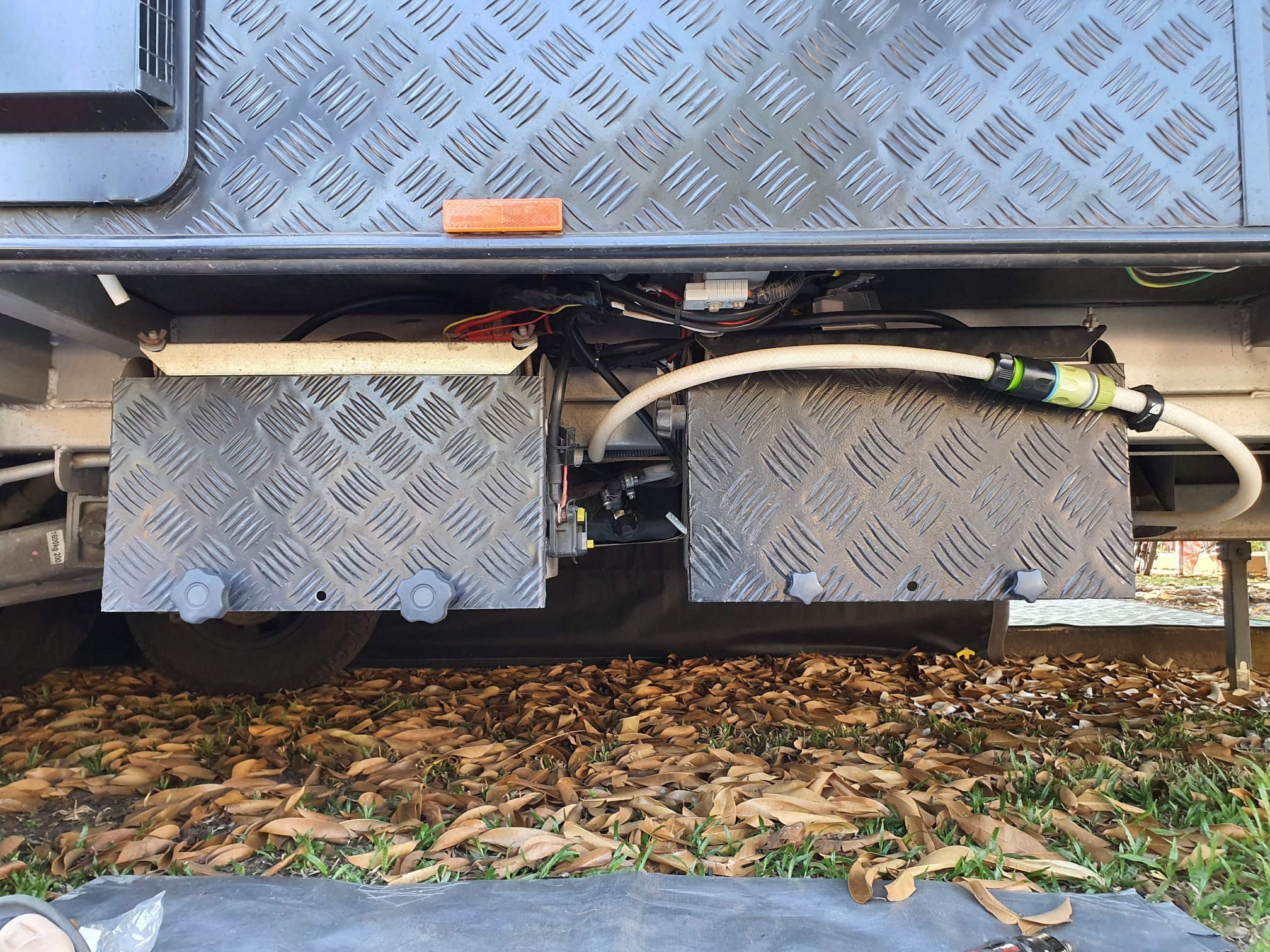
Now to the charging side. The claim is these can drop straight in and work with existing AGM chargers. Well.. yes and no. AGM Chargers do not fully charge due to the differences in final fully charged voltage comparing AGM to Lithium and also have different profiles for bulk, maintenance and storage etc. So not ideal in any way, but will work of sorts in an emergency. Unfortunately my Battery Management System in the van is 5 years old and does not have a Lithium charging profile. My Solar controller was also a cheapie ToPray 30amp PWM and I had been long wanting to upgrade that as well. With both the roof mounted and portable solar panels connected (150W + 160W) the max charging I could get was about 7 amps at midday.
So an upgrade was in order. I have now replaced the ToPray PWM Solar controller with a Victron Smart Solar 30amp MPPT controller and rewired the external auxiliary solar input to run through this controller as well so both the roof mounted and any portable panels will make the best of the MPPT controller (A quick test with ONLY the 160W portable panel at 4pm in Darwin with a smoke haze gave me 6.2 amps charge..) Yes I installed it upside down, this way the wiring input was on the top and reachable. As the old wiring was at the bottom, I cut out a hole behind it to allow access to the cabling to redirect it from the bottom holes to the top one. Not having a hole saw in my bag of tricks, I drew a circle (traced around a roll of electrical tape) then used a 5mm drill around the edge. Before drilling the last bit I pushed a metal skewer in from either side to stop it dropping in to the hole!
As for Solar panels, we have the original 150w on the roof of the van, a 160w folding portable panel and a 200w HardKorr portable panel that usually throw up on the awning roof. The 160w portable only comes out on days we are working and running 2 laptops and Starlink all day as well as the portable freezer and charging phones etc. The 30amp Solar Controller only supports max 400w input for 12v systems, however on overcast days the panels will be lucky to supply 5% to 20% of their capacity, so the more panels the better in that instance. Even on a good day the panels will usually at best get 75% to 95% of their rated outputs, depending on angle of the sun, strength of the sun (time of year), dirt and dust on the panels etc. For example, sitting way down south at Margaret River with all 3 panels out (510w max) I am averaging around 350w input giving me 25 amps into the batteries. So yes, the more panels the better!
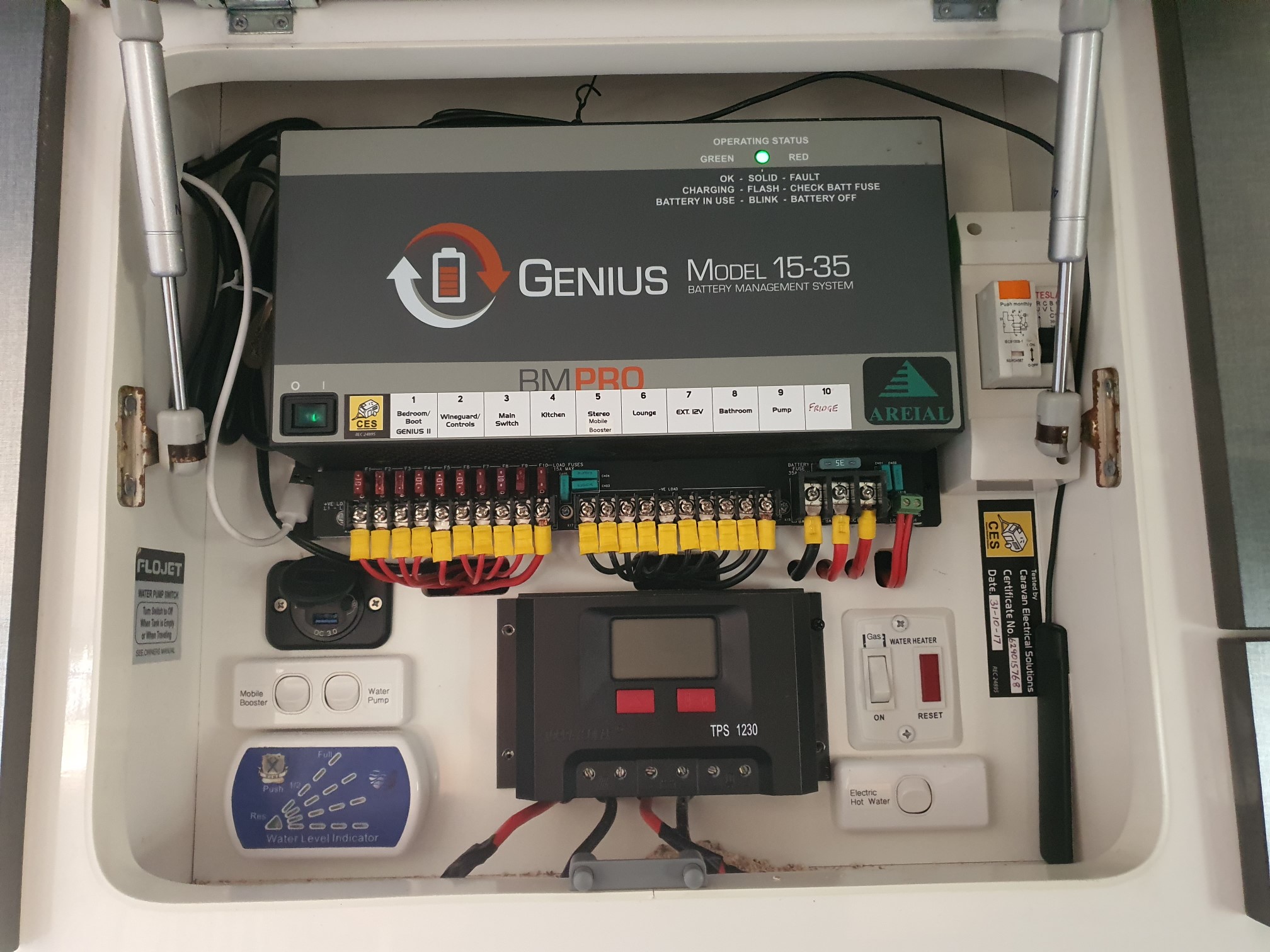
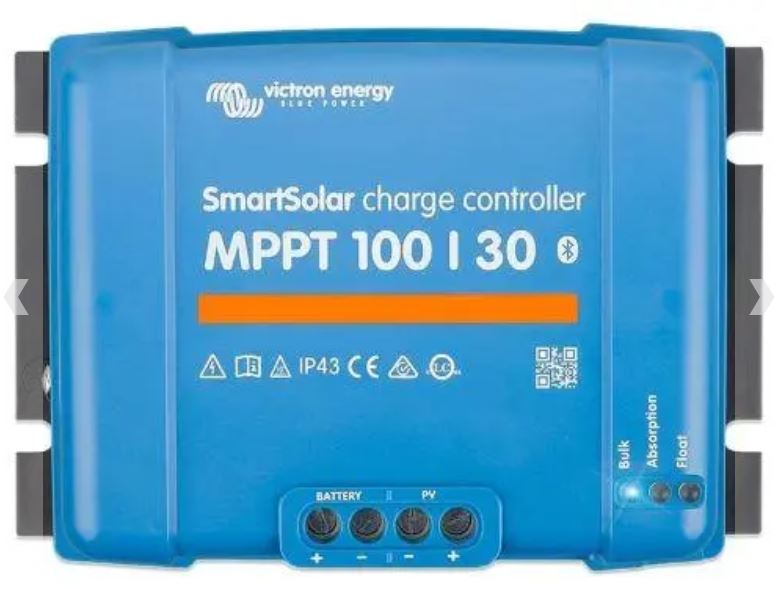
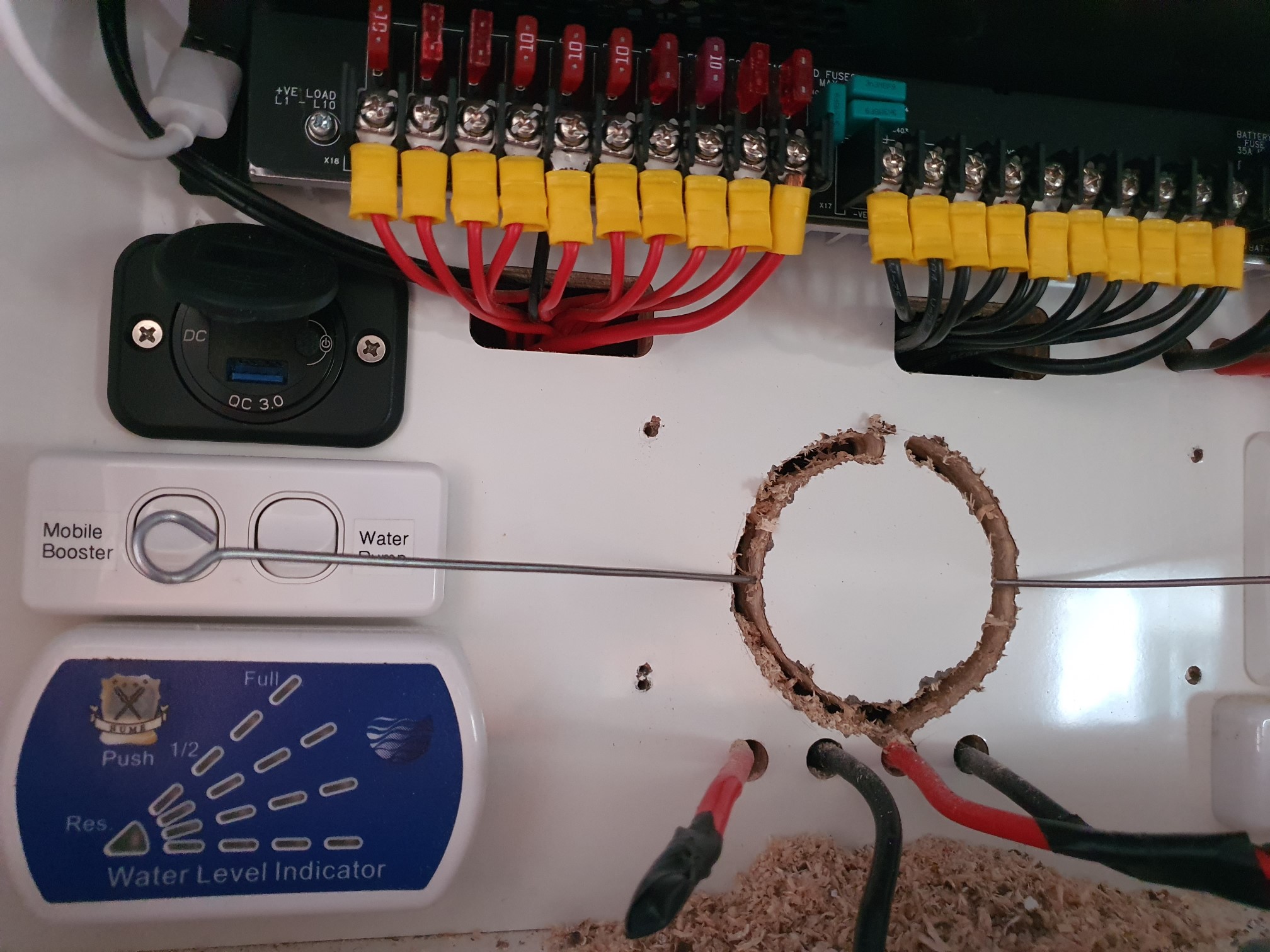
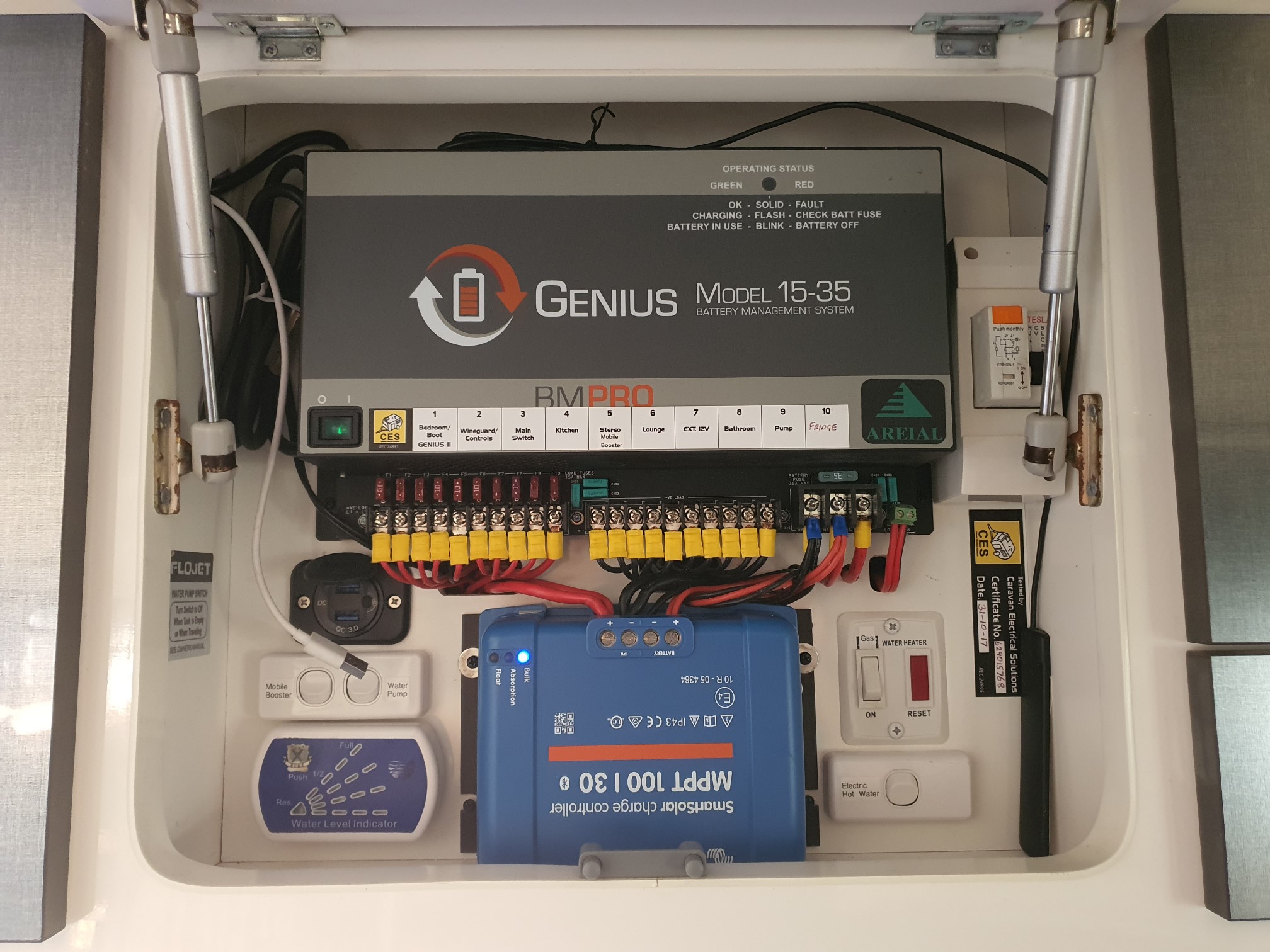
Next of course the BMPro is AGM only, but is also a battery management master switch and fuse box, and a grand or more to upgrade. So to fix this I invested in a Victron ACDC 30amp charger. This will get wired into the Battery terminals on the BMPro and the 240v power for the BMPro disconnected (the charger will use the original power point in the cupboard to the left where the BMPro is currently plugged in, so no problems with both ever being switched on together anyway.)
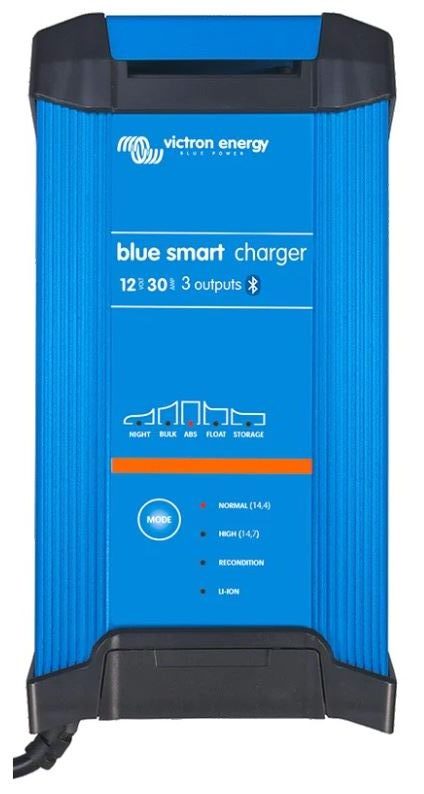
I already had a Victron BMV 712 battery monitor system that worked great, hence why I had no issues with using more Victron gear. The best part is they all have bluetooth monitoring from the same app as well, so I jump in and see what any of them are doing at any time. The Battery Monitor giving me the alarms for low battery as well.
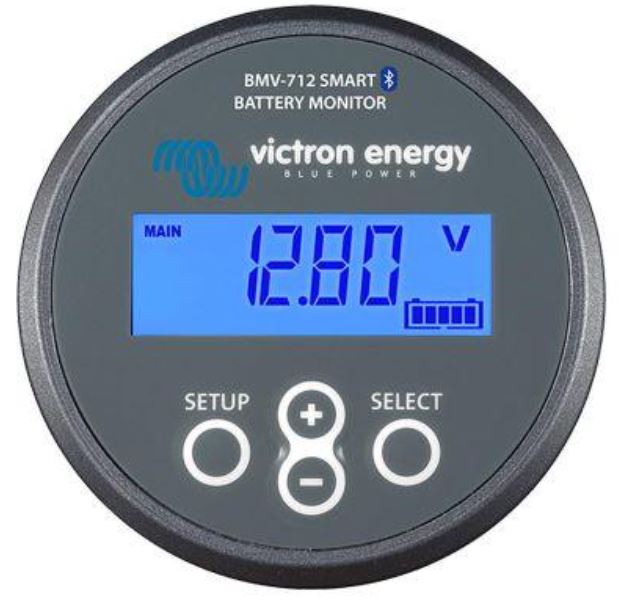
If you have any questions or queries on any of the above don’t hesitate to leave a message below, happy to help where I can. I should add from a personal experience side, all the Victron gear above was purchased at full retail through Everything Caravans, again.. Yep, again they had the best prices on the web and their delivery is superb – solar controller sent to the caravan park at Coober Pedy in 3 days, the AC charger to the caravan park at Darwin in 4 days! Love those guys! The batteries were sourced from Aussie Batteries on the Sunshine coast QLD. The original AGM batteries failed prematurely, but that’s what warranties are for. Aussie Batteries were wonderful through the whole warranty process with my new batteries also travelling all the way to Darwin and now working great.
If you are interested, we also run a 3000w inverter (the main reason I wanted to ‘balance’ the battery wiring, a brief write up on that is on the Inverter blog post.
UPDATE:
Recently I noticed the solar MPPT was dropping out of charging early, well before the battery was full. In this instance I had connected 2 external panels (a 160w and a 200w) as it was a cloudy day. Every now and then the sun would pop out and the charge would shoot up to just under 30amps. However the battery voltage was showing much higher than the actual voltage due to loss in the cables. Then I discovered (from the helpful people on Victron FaceBook page) that the systems can be networked together via BlueTooth so that the Solar Controller is being told the actual real battery voltage and currents directly from the Battery Monitor (using its shunt connected at the battery). So now the MPPT Solar Controller knows the exact voltage and continues to charge properly right up to full. Pretty nifty!
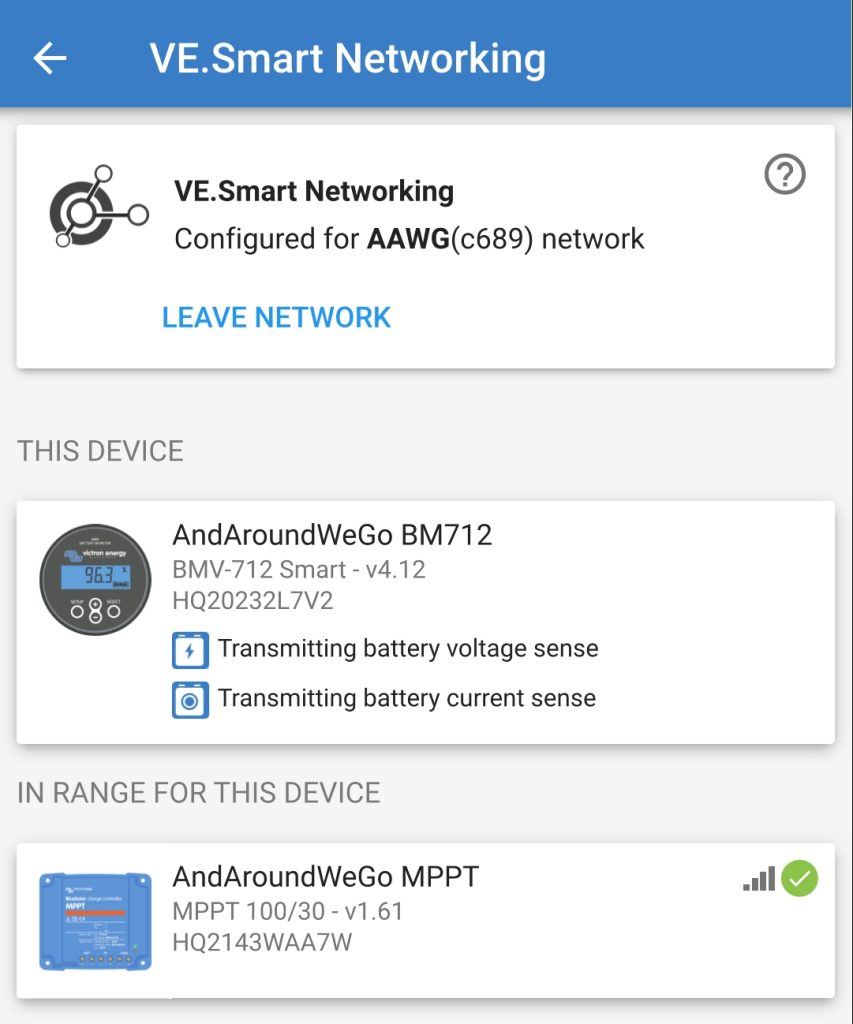
UPDATE May 2023:
I have noticed our solar charging is deteriorating as we grow closer to winter, which is quite normal. However I was not prepared for how much it would deteriorate – around 50% decrease in solar power generation! Rather than going into it in depth here though, I have written a separate blog for this accessible here. To solve the problem, and to help for a few cloudy days I invested in a cheap generator rather than a few thousand upgrading the solar that still won’t work if its cloudy. Generator was only $389 for a 2kw.


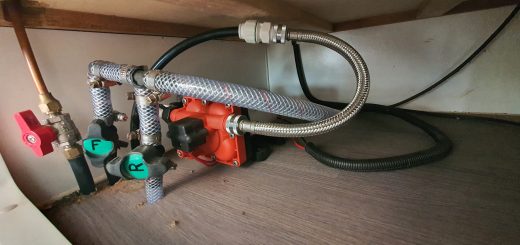
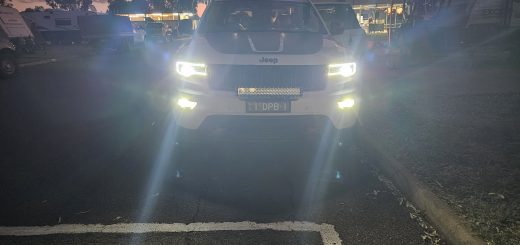
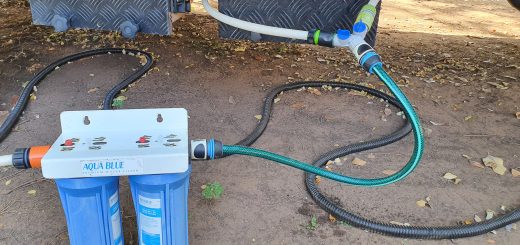
Hi Dave, we have just ordered a new Red Centre Newell+ van (due for delivery April/May). We are having a compressor fridge so is coming with 2 AGM batteries. Would you recommend us going for Lithium now instead of AGM? Apparently, Lithium will just drop in if we want to change down the track. We don’t plan on doing a great deal of free camping – we have never done this before, always opting for CPs but now we are retired, we plan to “dip our toes in the water” with free camping. We are very clueless with all of this. Thankyou so much, Karen & Peter
Hey Karen. I would consult the dealer and see what they would charge to upgrade to Lithium at the build phase. No double spending that way! For me the 2 Lithiums saved me 40kg, that’s a lot.. also with a compressor fridge it will run much better and much longer on the Lithiums. So yes, I would highly recommend upgrading at this stage. Be careful what they want to charge you for Lithiums though, often you will be much better sourcing your own and getting a small amount refunded for the non used AGM batteries. The only reason I did not go Lithium originally was they were double the prices they are now and my whole system had to be upgraded to suit. Cheers, Dave.
Hi Dave, great posts. I have a similar Van 2017 Essential Tourer series 7, with BMPro Genius too. I have 100amp AGM under the bed from Factory, and really want lithium. your solution make so much sense, but I have a couple of questions. By discounting the BMPro from 240Volt, when you are lookups, how does the aircon work, and can the Fridge still work on 240? do you dc2dc charger, I think see it into the BMPro, mine doesn’t work this way, as my DC2Dc need to see battery voltage? you sound like you know what you are doing, could you please advise me please, and give me your opinion. Thanks George, more question but though I could start here :-)….
Hey George. The BMPro 240v power conection is only for its internal battery charger – so unplugging the 240 power lead from the BMPro and connecting an external Victron 240v charger to the battery terminals on the BMPro has simply replaced the 240v battery charging section of the BMpro. Nothing else is unplugged and 12v side of things remains unchanged. So fridge and aircon still work as normal when at a powered site. The connection from the car to the BMPro has a large diode inside the BMPro to stop back feeding power to the car. Unfortunately as you mention, this stops most DC2DC chargers from working as they can not sense the batteries in the van. Quick and simple work around for that is to remove the Red DC +ve in from the far right of the BMPro thick cables (this is the one from the car and the one that is diode prtected from the batteries) and move it one spot to the left, connecting it to the +ve batery terminal of the BMPro. This was your DC2DC charger will be connected directly across the batteries. The only downside is that cable is now live from the bateries, meaning the connector at the front of the van to the car is also live from the batteries. However there is not really any other way to do this so the DC2DC charger can ‘see’ the bateries. Personally I do not have a DC2DC charger from the car, just using the existing setup directly from the car battery system. Charge is not as good as it could be but still pumps in good current even with my smart alternator.
Hey Dave, thanks for your advise, it makes good sense. Only had my van a month, and the dealer installed the DC2DC for me, I did contact them and they are supposed to come and have a look, but I guess Christmas has got in the way. I have my eye on a 200amp Lithium Battery, which should give me 4 time more storage, and allow me to install a 1500watt Kings inverter I have has for a couple of years. the journey has only just begun for us. I will move the cable as suggested and put a weather cover on the Anderson plug out the front so it should be ok when not plugged in :-). you talk about Everything Caravans, is that the company in Braeside Victoria? if so I will visit them and see about the 240v Charge (Victron), MMPT controller and maybe another solar panel as I only have 1 at this time 170w mounted on the roof. Your site is a wealth of knowledge and I will list again, please keep up the great work and enjoy your travels, and I look forward to chatting again. Thanks and Merry Christmas to you and your family. Stay Safe. BTW I have joined you Facebook group too.
Hey George, happy to help where I can! Yes, Everything Caravans in Victoria, have ordered from them half a dozen times now and always best price so far and really quick on freight.
You and your family have a great Christmas and hopefully will catch you on the road one day!
Hi, while your article is correct, your sidestep at the beginning is incorrect. LiFePO4 can also be made in a polymer construction. It’s a packaging method and not chemistry. Just because a chemistry is packaged as polymer for mobiles etc. doesn’t mean all polymer batteries are the same. LiFePO4 (LFP) can go into thermal runaway so it’s wrong to say they can’t. It’s just that it’s MUCH harder and it needs a higher temperature. The more volatile lithium ion chemistry often used in cameras, laptops etc are Lithium Nickel Manganese Cobalt Oxide (NMC) are much more dangerous and more easily put into thermal runaway. Various gases given of by Cobalt burning are also extremely dangerous. Also, because many compact devices use a polymer construction and use the more energy dense but more dangerous NMC chemistry, the polymer can be punctured making them more prone to thermal runaway with damage
Hey Greg, thanks for the feedback. I was over generalising, making the point that the LiFePO4 batteries used in Caravans are not the same as LiPo or Li Ion that are bursting into flames from mis use in power tools and electric toys (like scooters, bikes, EV cars etc). Yes I agree that LiFePO4 can go into Thermal Runaway, but this is generally only caused by over charging which the inbuilt BMS is designed to avoid. I have also seen many videos of LiFePO4 being shot, had metal arrows shot through them, steel spikes driven through them etc. This will cause the LiFePO4 to vent like crazy in a very similar way to a LiPo fire jet – just without the fire part. I have not yet found a (valid) report of thermal runaway causing combustion as yet on a LiFePO4, but understand under the correct conditions it could occur. This was my main point, they should not be lumped into the same basket of potential fire bombs that previous Lithium based batteries are well entrenched in. The reason for this info was to reduce the fear factor from comments like “never put them in your caravan if you value your life, as they are way too dangerous and will burst into flames”. In my personal life I use Lithium Polymer batteries in Remote Piloted Aircraft and have witnessed many of them self combust in glorious fashion from either too high a current draw or crash landings over the last 10 years. Most recently it has been with small racing drones with the battery mounted below – too many hard landings on the battery then when next charged they go up in flames. If you do see any reports of the deep cycle LiFePO4 batteries that are commonly used in caravans, please shoot me a message and a link and I will update the post with the details.
Hi again Dave, could I ask a question again, sorry but getting away more now so my mind is working hard. How do you get behind the charger in the cupboard? I note you said you moved the cable from the external solar Anderson, into the same MPPT, but for the life of me I cannot work out how to get behind the panel to fee in new cables? Also the dealer put my dc2 dc in the next cupboard and fed the cables in to the electrical cupboard and I want to remove it and put the dc2dc under the bed next to the battery. Can you advise me please. Absolutely no videos on YouTube on this area of the essential van. Thanks again, and I hope Tassy is being kind to you. Thanks George
Hi Dave, this article is what I’ve been looking for. I’m currently looking at a 2nd hand 21 model new age. The bmpro is only for agm. I currently have 2x100ah lithium, victron 240v charger, smartsolar reg, dcdc and bmv shunt. If I buy the van I am hoping I might be able to integrate the victron gear into the existing bmpro gear.